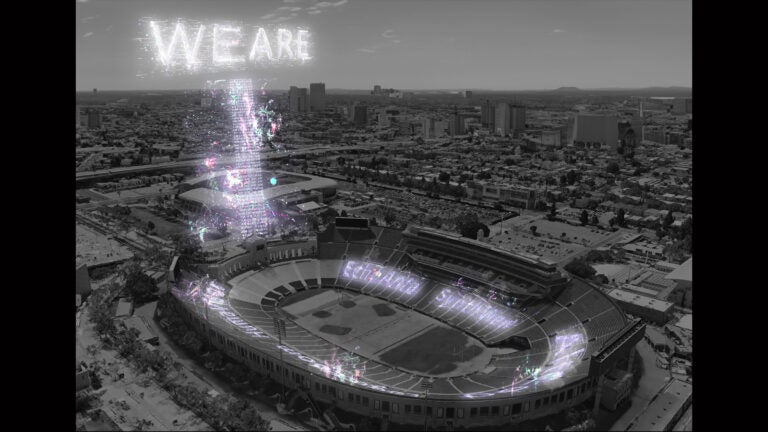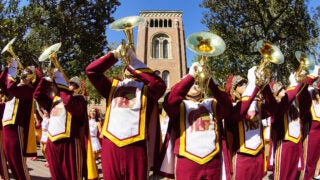
Computer rendering for WE ARE: Explosion Event for PST ART, 2024. Courtesy Cai Studio.
An explosive kickoff to a landmark arts event
USC will host a spectacular fireworks display at the Coliseum to mark the opening of the arts extravaganza PST ART. Also on the agenda: art exhibitions and a symposium.
When dusk falls on Sept. 15, nearly 10,000 twinkling mini-firework shells installed throughout the Los Angeles Memorial Coliseum will transform the historic stadium into a matrix of animated light. Choreographed in collaboration with an artificial intelligence model, more than 1,000 aerial drones carrying pyrotechnic products will ignite the sky above and around the bowl with bursts of colorful imagery.
Is it art? Is it science? Turns out it’s both.
The event, titled WE ARE and developed by artist Cai Guo-Qiang, will mark the official start of Getty’s PST ART, a Southern California arts initiative whose theme this year is Art & Science Collide. Featuring more than 800 artists and 70 exhibitions and running through Feb. 16, this third edition of PST ART (formerly known as Pacific Standard Time) will showcase work exploring the intersection of art and science at cultural, scientific and community organizations across the region.
USC, a leader in science and art, will play a prominent role in PST ART by hosting the opening fireworks show at the Coliseum, which the university manages, and art exhibitions at the USC Pacific Asia Museum and the USC Fisher Museum of Art.
“We are very excited to see Cai Guo-Qiang bring his technical and artistic wizardry to the Coliseum, and we appreciate the collaboration with the Getty,” USC President Carol Folt said.
“Hosting two major PST ART exhibitions steeped in the spirit of both university and community collaboration, USC Museums is so proud to play a major role in expanding art into unchartered corners of the university and to champion the arts in our community,” said Bethany Montagano, director of USC Museums.
USC moonshots aligned
PST ART comes at a time when USC is focused on a series of “moonshot” goals laid out by Folt that include accelerating advanced computing and expanding the exploration of the arts across health, computing and sustainability.
“WE ARE fits like a glove with USC’s moonshots,” Folt said. “It will help push the frontiers of AI and advanced computing even further, and break new ground in the arts with game-changing technology and science — all of this while feeding the innovative spirit that pulses through our community.”
USC has been a hub of AI innovation for decades. Research at the USC Information Sciences Institute and the USC Institute for Creative Technologies, both affiliated with the USC Viterbi School of Engineering, has shaped the development of technologies including natural language processing and conversational AI. USC alumni have played a formative role in generative AI tools, including ChatGPT. The university’s $1 billion Frontiers of Computing initiative, launched last year, has expanded computing research in AI, machine learning and data science, with ethics at its core. It calls for the infusion of AI into all of USC’s 23 schools to spark creativity, collaboration and transformation.
The recently launched USC Center for Generative AI and Society — a collaboration among the USC Annenberg School for Communication and Journalism, the USC School of Cinematic Arts, the USC Jimmy Iovine and Andre Young Academy, the USC Rossier School of Education and USC Viterbi — is catalyzing cross-pollination between AI and the arts. One example is the center’s AI for Media and Storytelling initiative, which explores AI-assisted filmmaking, immersive environments, neural graphics, music visualization and more.
Another example of USC’s burgeoning art-meets-AI ecosystem is the recent art exhibition City Ascendant: Imagining the Future of L.A. through A.I. — a collaboration between the USC Wrigley Institute for Environment and Sustainability and the School of Cinematic Arts. The show’s faculty and student creators used generative AI tools to create dreamlike scenes of a futuristic, eco-conscious Los Angeles.
Cai, who designed the pyrotechnics for the 2008 Beijing Summer Olympics, is a contemporary artist known for larger-than-life outdoor “explosion events.” In creating WE ARE, the artist employed an AI model he developed called cAI (pronounced AI Cai) that deep-learns from his artwork, archives and areas of interest.
The model helped Cai conduct site visits, research materials, plan the pyrotechnic drones’ flight paths and execute other aspects of the creative process. Through imagery, the fireworks display will explore the relationship between humanity and AI.
Evocative exhibitions
Pyrotechnics and gunpowder have figured prominently in Cai’s work over the past several decades. At the USC Pacific Asia Museum, the exhibition Cai Guo-Qiang: A Material Odyssey — part of PST ART and running from Sept. 17 through June 15 — will shed light on the artist’s lifelong engagement with these explosive materials, which bring an element of surprise into his paintings, drawings and events. Cai will join interviewer and cultural interlocutor Paul Holdengräber at the museum on the evening of Sept. 16 for a conversation to kick off the exhibition.
Based on years of research by the Getty Conservation Institute and the Getty Research Institute, the exhibition will display a vast selection of the artist’s work. Scientific imagery will also explore the nature of gunpowder, its influence on Cai’s work and how Cai’s process has evolved. Programs accompanying A Material Odyssey will include videos illustrating the making of fireworks, the process of creating gunpowder paintings, interactive displays, and a variety of film screenings and conversations.
“We are proud to collaborate with the Getty and the dynamic team at Cai Studio to bring this exhibition to USC Pacific Asia Museum,” Montagano said. “Not since the Marcel Duchamp exhibition in 1963 has a single artist occupied such a significant footprint of the building’s gallery space. Cai Guo-Qiang and his incredible creative output epitomize the innovative work USC is doing on the frontiers of art and AI. A Material Odyssey seamlessly connects with this year’s PST ART theme, Art & Science Collide, and we are thrilled to bring this historic and transformative exhibition to our community.”
Both WE ARE and A Material Odyssey are generously supported by USC Life Trustee Ming Hsieh and his wife, Eva, and USC Trustee Dominic Ng and his wife, Ellen.
“Ming and Dominic — who were integral to USC’s decision to acquire the USC Pacific Asia Museum in 2013 — are involved in these projects on a whole host of levels,” Montagano said. “USC would not have had the opportunity to work with Cai and form such a robust partnership with the Getty on these endeavors unless Ming and Dominic brought these opportunities to us at USC. They are ardent supporters of Cai’s incredible work and artistic practice.”
Also debuting under the PST ART umbrella is the USC Fisher Museum of Art exhibition Sci-fi, Magick, Queer L.A.: Sexual Science and the Imagi-Nation. The show is curated by ONE Archives at the USC Libraries, the largest repository of LGBTQ materials in the world. The exhibition, which opened Thursday and runs through Nov. 23, considers the importance of science fiction fandom and occult interests to U.S. LGBTQ history.
Focusing on Los Angeles from the late 1930s through the 1960s, the USC Fisher Museum show follows the lives of writers, publishers and early sci-fi enthusiasts who worked together to envision and create a world of their own making through films, photographs, music, illustrations, costumes and writing. Programming will include film screenings, panel discussions and a Halloween cosplay event.
The exhibition is the first major collaboration between ONE Archives and the USC Fisher Museum, Montagano said. “The exhibition enriches Los Angeles’ broader history, reflecting the critical importance of making the narratives of marginalized people visible and legible to the wider public,” she said.
Man meets machine
The day after WE ARE takes place, on Sept. 16, USC will partner with Cai to host “Beyond the Human?: From the Metaphysical to the Physical,” a daylong symposium exploring the impact of AI on the arts. Co-curated by Cai and USC Vice Provost for the Arts Josh Kun and co-sponsored by USC Visions and Voices and the USC Center for Generative AI and Society, the symposium will feature speakers and performers from the worlds of visual art, dance, technology, literature, architecture, film and music converging around questions raised by the emergence of AI. It will be held in Bovard Auditorium on the USC University Park Campus.
Kun oversees USC Arts Now, a new arts “moonshot” initiative launched by Folt to grow collaborations across the health sciences, computing and other disciplines. The initiative will draw upon USC’s rich resources in creative expression, including its six professional arts schools: the USC School of Architecture, the USC Roski School of Art and Design, the USC School of Dramatic Arts, the USC Kaufman School of Dance, the USC School of Cinematic Arts and the USC Thornton School of Music.
“The symposium is the first public event of USC Arts Now, and it’s incredibly timely,” said Kun, professor and chair of cross-cultural communication at USC Annenberg. “As AI continues to upend how we think about art and creativity, the symposium highlights the perspectives of leading artists and thinkers who are tackling big questions: How is AI expanding the boundaries of the human? Is the definition of the artist changing in the face of advanced computation?”
Though “Beyond the Human?” is not part of PST ART, its themes dovetail with it. “To have the symposium fall during the calendar of PST ART is extra special — an occasion to further explore the collisions of art and science that happen every day across the university’s campuses,” Kun said.
The scholar of music and culture has curated music-related exhibitions, projects and programming for the two previous iterations of PST ART, held in 2011 and 2017. This year, Kun has organized PST ART’s Quantum Vibrations, which explores the intersections of art and science through music and sound. The four-part series will be held at sites throughout Los Angeles from Oct. 4 through Nov. 17, and include musical meditations on nuclear research, desert biomes and nonhuman music makers.
Kun has welcomed the opportunities that PST ART is providing to think beyond silos and explore new technologies. “It’s a perfect match for our campus where the arts intersect with computing and the sciences in exciting new ways,” he said.



